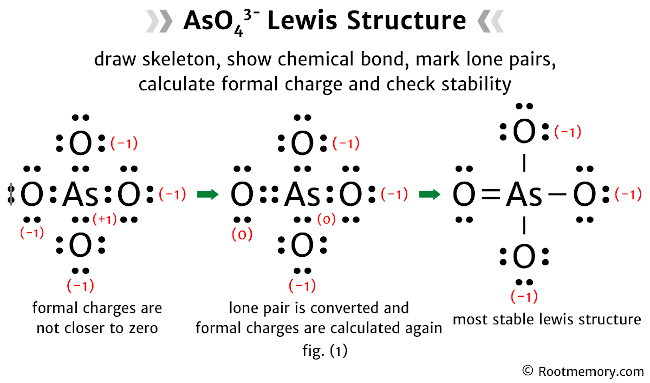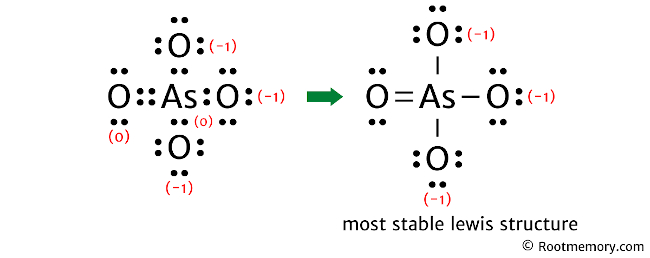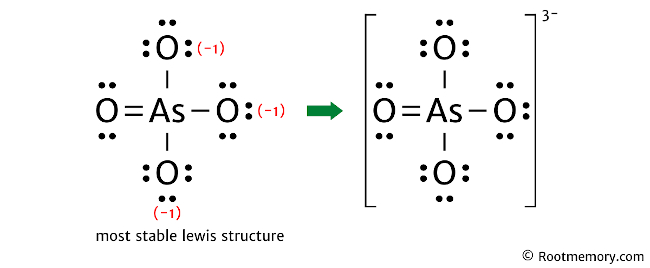
The Lewis structure of AsO43- contains one double bond and three single bonds, with arsenic in the center, and four oxygens on either side. The left oxygen atom has two lone pairs, the right oxygen atom, top oxygen atom, and bottom oxygen atom has three lone pairs, and the arsenic atom does not have any lone pair.
Plus, there is a negative (-1) charge on the right oxygen atom, top oxygen atom, and bottom oxygen atom.
Alternative method: AsO43- Lewis structure
Steps
Rough sketch
In this step, first calculate the total number of valence electrons. And then, decide the central atom.
- Let’s calculate the total number of valence electrons
We know that… arsenic is a group 15 element and oxygen is a group 16 element. Hence, arsenic has five valence electrons and oxygen has six valence electrons.
Now AsO43- has one arsenic atom and four oxygen atoms.
So the total number of valence electrons = valence electrons of arsenic atom + (valence electrons of oxygen atom × 4)
And AsO43- has a negative (-3) charge, so we have to add three more electrons.
Therefore, the total number of valence electrons = 5 + 24 + 3 = 32
- Now decide the central atom
The atom with the least electronegative value is placed at the center. By looking at the periodic table, we get the electronegativity values for arsenic and oxygen as follows:
Electronegativity value of arsenic = 2.18
Electronegativity value of oxygen = 3.44
Obviously, arsenic is less electronegative than oxygen. Hence, assume that arsenic is the central atom.
So now, put arsenic in the center and oxygens on either side. And draw the rough skeleton structure for the Lewis structure of AsO43- something like this:

Also read: How to draw Lewis structure of GeCl4 (4 steps)
Chemical bond
Place two electrons between the atoms to show a chemical bond. Since arsenic is surrounded by four oxygens, use eight electrons to show four chemical bonds as follows:

Lone pair
As calculated earlier, we have a total of 32 valence electrons. And in the above structure, we have already used eight valence electrons. Hence, twenty-four valence electrons are remaining.
Two valence electrons represent one lone pair. So twenty-four valence electrons = twelve lone pairs.
Note that arsenic is a period 4 element, so it can keep more than 8 electrons in its last shell. And oxygen is a period 2 element, so it can not keep more than 8 electrons in its last shell.
Also, make sure that you start marking these lone pairs on outside atoms first. And then, on the central atom.
The outside atoms are oxygens, so each oxygen will get three lone pairs. And the central atom (arsenic) will not get any lone pair, because all twelve lone pairs are used.
So the Lewis structure of AsO43- looks something like this:

In the above structure, you can see that the octet is completed on the central atom (arsenic), and also on the outside atoms. Therefore, the octet rule is satisfied.
Now calculate the formal charge and check the stability of the above structure.
Also read: How to draw Lewis structure of C2H2F2 (5 steps)
Formal charge and stability
The following formula is used to calculate the formal charges on atoms:
Formal charge = valence electrons – nonbonding electrons – ½ bonding electrons
Collect the data from the above structure and then, write it down below as follows:
- For arsenic atom
Valence electrons = 5
Nonbonding electrons = 0
Bonding electrons = 8
Formal charge = 5 – 0 – ½ (8) = +1
- For each oxygen atom
Valence electrons = 6
Nonbonding electrons = 6
Bonding electrons = 2
Formal charge = 6 – 6 – ½ (2) = -1
Mention the formal charges of atoms on the structure. So the Lewis structure of AsO43- looks something like this:

In the above structure, you can see that the formal charges of atoms are not closer to zero. Therefore, convert lone pair and calculate formal charge again.
Also read: How to draw Lewis structure of CH2CHCN (5 steps)
Reevaluate lone pair and formal charge
As mentioned earlier, arsenic is a period 4 element, so it can keep more than 8 electrons in its last shell.
So convert one lone pair from one oxygen atom to make a new bond with the arsenic atom. And then, the Lewis structure of AsO43- looks something like this:

Now one last thing we need to do is, calculate the formal charge again and check the stability of the above structure.
Formal charge = valence electrons – nonbonding electrons – ½ bonding electrons
Collect the data from the above structure and then, write it down below as follows:
- For arsenic atom
Valence electrons = 5
Nonbonding electrons = 0
Bonding electrons = 10
Formal charge = 5 – 0 – ½ (10) = 0
- For left oxygen atom
Valence electrons = 6
Nonbonding electrons = 4
Bonding electrons = 4
Formal charge = 6 – 4 – ½ (4) = 0
- For right oxygen, top oxygen, and bottom oxygen atom
Valence electrons = 6
Nonbonding electrons = 6
Bonding electrons = 2
Formal charge = 6 – 6 – ½ (2) = -1
Mention the formal charges of atoms on the structure. So the Lewis structure of AsO43- looks something like this:

In the above structure, you can see that the formal charges of atoms are closer to zero. Therefore, this is the most stable Lewis structure of AsO43-.
And each horizontal line drawn in the above structure represents a pair of bonding valence electrons.
Now AsO43- is an ion having a negative (-3) charge, so draw brackets around the above Lewis structure and mention that charge on the top right corner. And then, the Lewis structure of AsO43- looks something like this:

Next: Lewis structure of GeCl4
Related
- Lewis structure of GeCl4
- Lewis structure of C2H2F2
- Lewis structure of CH2CHCN
- Lewis structure of TeBr4
- Lewis structure of GeH4
External video
- How to Draw the Lewis Dot Structure for AsO4 3-: Arsenate ion – YouTube • Wayne Breslyn
External links
- AsO43- Lewis Structure in 5 Steps (With Images) – Pediabay
- Arsenate Ion (AsO43-) – Lewis Structure – Chemistry School
- Lewis Structure of (AsO4)3- – Laurence Lavelle
- Draw and explain the Lewis structure of the most important resonance form of the ion AsO43- – Homework.Study.com
- Draw the Lewis structure of AsO43- showing all lone pairs – Chegg
- Arsenate ion | AsO4-3 | CID 27401 – National Institutes of Health (.gov)
- Draw a Lewis structure for the resonance form of AsO4-3, with the lowest possible formal charges – Brainly
- What is the Lewis structure for AsO43-? – OneClass
- Draw the Lewis structure and identify the molecular geometry of AsO43- – Numerade
- Draw the Lewis structure of AsO43- showing all lone pairs – Bartleby
- Drawing the Lewis Structure for AsO33- (Arsenic Trichloride) – The Geoexchange
- (AsO4)3- (Arsenate Ion) Oxidation Number – ChemicalAid
- What is the oxidation state of arsenic in the arsenate ion, AsO43? – Quora
Deep
Rootmemory.com was founded by Deep Rana, who is a mechanical engineer by profession and a blogger by passion. He has a good conceptual knowledge on different educational topics and he provides the same on this website. He loves to learn something new everyday and believes that the best utilization of free time is developing a new skill.
